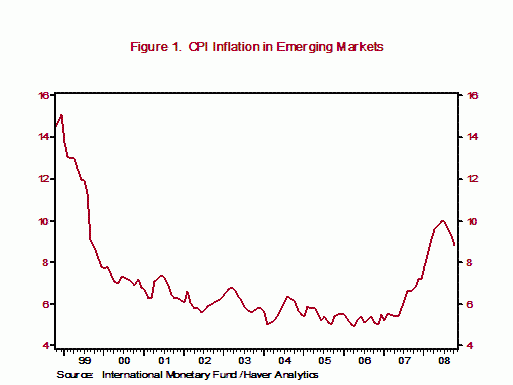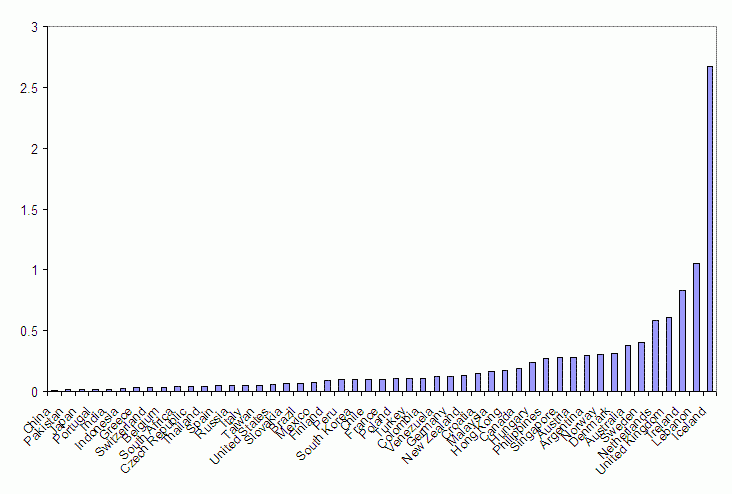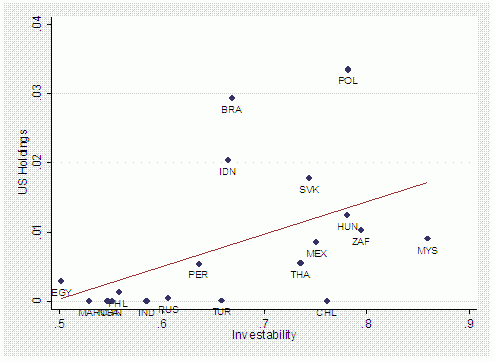Emerging market crises in the 1990s were exacerbated by currency mismatches that were at least somewhat related to the underdevelopment of local debt markets. The underdeveloped markets encouraged companies and governments to seek lower borrowing costs in foreign currency instruments. When local currencies depreciated, many companies immediately became bankrupt, starting a downward spiral that was difficult to break.
The crises of the 1990s left a mark on many emerging market countries, whether they were directly impacted or not. As argued in Caballero et al (2008), the crises dealt a damaging blow to financial development in emerging economies around the globe, and the resulting lack of reliable financial instruments in emerging economies channelled global savings toward industrial countries, particularly the US. While one might have reasonably expected the US financial system to be able to intermediate the concomitant large capital inflows, the facts suggest it was not up to the task.
There are a myriad of factors that led to the current and the 1990s crises. I won’t discuss those here, but instead will focus on one feature of the international financial system that could have ameliorated both sets of crises, the development of local currency bond markets around the world.
Consistent with the CFG hypothesis, local currency bond markets in emerging market economies (EMEs) are quite small at about one-third of GDP (compared with developed country markets of 100% of GDP or more). There are differences across and within emerging market regions. Bond markets in Latin America are markedly smaller than those in emerging Asia, and Latin American firms and sovereigns tend to issue much more in foreign currency. While bigger is not always better – many probably wish that the US bond market didn’t grow to 161% of GDP – a larger, deeper bond market can promote growth and development. And, as Table 1 indicates, local bond markets in both Latin America and emerging Asia grew the past few years.
Table 1 Local-currency-denominated (LCD) bonds
| |
Size (% of GDP) |
Composition (LCD as % of total) |
| |
2001 |
2006 |
2001 |
2006 |
| Euro area |
99 |
141 |
90 |
91 |
| US |
136 |
161 |
98 |
97 |
| Other developed |
85 |
105 |
87 |
81 |
| Emerging markets |
28 |
33 |
75 |
83 |
| Latin America |
18 |
20 |
51 |
67 |
| Asia |
37 |
43 |
90 |
92 |
Source: Burger, Warnock, and Warnock (2009), using BIS data
Burger and Warnock (2006) highlighted the importance of policies and laws in explaining cross-country differences in bond market development. They found that countries with stable inflation rates and strong creditor rights have more developed local bond markets and rely less on foreign-currency-denominated bonds. The implication from that study was clear. In part by improving policy performance and strengthening institutions, countries could develop local currency bond markets, reduce their currency mismatch, and lessen the likelihood of future crises.
Over the past decade, one of the macro factors that enabled the development of local bond markets was strong performance on inflation. Gone are the days of 50%, 60%, 100% inflation rates in emerging markets. In part because of inflation targeting policies, in part because of a benign global environment, average EME inflation trended downward to around 5% by the end of 2006 (Figure 1), enabling bond market development. The spike in inflation in 2007 and the first half of 2008 raised questions about many countries’ commitment to inflation targeting. While those concerns are temporarily on the backburner with the global financial crisis, they will surely be revisited when global growth resumes.
Figure 1 CPI inflation in emerging markets
While Table 1 shows that there has been progress in local bond market development and somewhat reduced reliance on foreign currency debt, not all bond market development is equal. The aggregate numbers can hide, in particular, vast differences in corporate bond markets. For example, while heightened spreads among Euro Area sovereign bonds have been the focus of much press recently, Biais et al (2006) note that the European corporate bond market has become unified, deep, and a low cost place for firms from many countries to raise funds. Within emerging markets, the corporate bond market in China, for example, is almost non-existent (relative to the size of the economy) while that in Malaysia is rather well developed. Moreover, currency mismatch problems have not altogether disappeared. Figure 2 shows that as of end-2006 while many countries had very little foreign-currency-denominated debt, many others had outstanding foreign currency bonds that totalled 25% or more of GDP (with one notable outlier at almost 3 times GDP).
Figure 2. Ratio of outstanding foreign-currency-denominated bonds to GDP
It is uncontroversial to say that local currency bond market development can lessen currency mismatches and therefore break one link from depreciation to crisis. With deeper local markets, more borrowing and lending can take place within a country’s borders, perhaps reducing the incentive to go abroad. Another question is whether global investors will actually lend in your currency. The US, of course, has that privilege (perhaps to too great an extent, with foreigners holding over one-quarter of all outstanding US bonds), but few others do. Data on the extent of foreign participation in local currency bond markets is notoriously lacking, but partial data can be gleaned from US reports. Such data show that while US participation in local currency bonds is quite low, it has been increasing in emerging markets (Burger et al 2009). Moreover, at least at some level, countries with greater “investability” scores (defined using data on capital controls, market liquidity and efficiency, regulatory quality and creditor rights, market infrastructure, taxation on bonds, and the size of the local institutional investor base) seem to attract more US investment (Figure 3).
Figure 3. US Investment and investability
Source: Figure 2 from Burger et al (2009). US Holdings is the portion of the country’s outstanding local currency bonds that is held by US investors; bond holdings data are as of end-2006 from Treasury Department et al. (2007). Investability is from CRISIL’s Gemloc Investability Indicators.
The prudent development of local securities markets is one avenue toward global financial stability. Local currency bond market development can lessen the probability that a currency depreciation will morph into a full blown financial crisis. Consistent with Caballero et al (2008), local currency bond market development could also reduce the massive inflows into US debt securities and hence begin to unwind global imbalances. Countries and international institutions realize that financial sector development has benefits, and there are currently many programs aimed at various aspects of bond market development.1 The question isn’t whether we will see more bond market development going forward. We will. The main question is, how and where will local markets develop?
Editors' note: This column is a Lead Commentary on Vox's Global Crisis Debate where you can find further discussion, and where professional economists are welcome to contribute their own Commentaries on this and other crisis-linked topics.
References
Biais, Bruno; Fany Declerc; James Dow; Richard Portes; and Ernst- Ludwig von Thadden (2006). European Corporate Bond Markets: transparency, liquidity, efficiency, CEPR, London, UK.
Burger, John D.; and Francis E. Warnock (2006). Local Currency Bond Markets. IMF Staff Papers 53: 115-132.
Burger, John; Francis E. Warnock; and Veronica Cacdac Warnock (2009). Global Financial Stability and Local Currency Bond Markets. working paper.
Caballero, Ricardo; Emmanuel Farhi; and Pierre-Olivier Gourinchas (2008). An Equilibrium of “Global Imbalances” and Low Interest Rates. American Economic Review 98(1): 358-393.
1 The Asian Development Bank has a long-standing program to develop local bond markets; see, for example, www.asianbondsonline.adb.org. See also the World Bank’s Gemloc program (www.gemloc.org).





